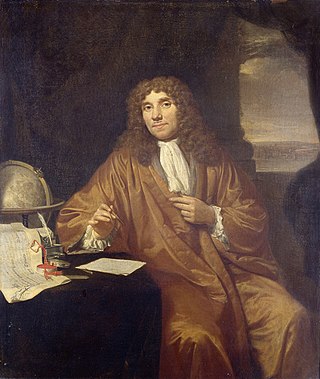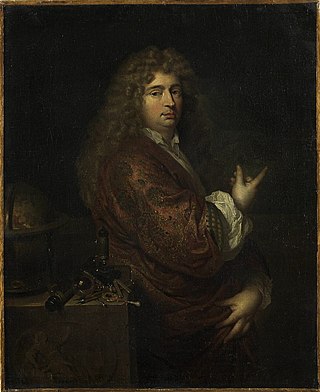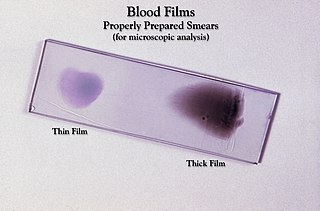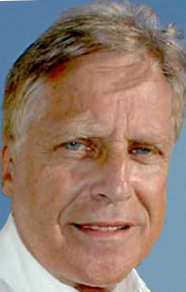
Christopher Cock was a London instrument maker of the 17th century, who supplied microscopes to Robert Hooke. These microscopes were compound lens instruments, which suffered greatly from spherical aberration.

Christopher Cock was a London instrument maker of the 17th century, who supplied microscopes to Robert Hooke. These microscopes were compound lens instruments, which suffered greatly from spherical aberration.

A microscope is a laboratory instrument used to examine objects that are too small to be seen by the naked eye. Microscopy is the science of investigating small objects and structures using a microscope. Microscopic means being invisible to the eye unless aided by a microscope.

Antonie Philips van Leeuwenhoek was a Dutch microbiologist and microscopist in the Golden Age of Dutch science and technology. A largely self-taught man in science, he is commonly known as "the Father of Microbiology", and one of the first microscopists and microbiologists. Van Leeuwenhoek is best known for his pioneering work in microscopy and for his contributions toward the establishment of microbiology as a scientific discipline.

Robert Hooke was an English polymath who was active as a physicist, astronomer, geologist, meteorologist and architect. He is credited as one of the first scientists to investigate living things at microscopic scale in 1665, using a compound microscope that he designed. Hooke was an impoverished scientific inquirer in young adulthood who went on to become one of the most important scientists of his time. After the Great Fire of London in 1666, Hooke attained wealth and esteem by performing more than half of the property line surveys and assisting with the city's rapid reconstruction. Often vilified by writers in the centuries after his death, his reputation was restored at the end of the twentieth century and he has been called "England's Leonardo [da Vinci]".

Timeline of microscope technology

In biology, cell theory is a scientific theory first formulated in the mid-nineteenth century, that living organisms are made up of cells, that they are the basic structural/organizational unit of all organisms, and that all cells come from pre-existing cells. Cells are the basic unit of structure in all living organisms and also the basic unit of reproduction.
The microscopic scale is the scale of objects and events smaller than those that can easily be seen by the naked eye, requiring a lens or microscope to see them clearly. In physics, the microscopic scale is sometimes regarded as the scale between the macroscopic scale and the quantum scale. Microscopic units and measurements are used to classify and describe very small objects. One common microscopic length scale unit is the micrometre, which is one millionth of a metre.

Micrographia: or Some Physiological Descriptions of Minute Bodies Made by Magnifying Glasses. With Observations and Inquiries Thereupon is a historically significant book by Robert Hooke about his observations through various lenses. It was the first book to include illustrations of insects and plants as seen through microscopes.

A micrograph is an image, captured photographically or digitally, taken through a microscope or similar device to show a magnified image of an object. This is opposed to a macrograph or photomacrograph, an image which is also taken on a microscope but is only slightly magnified, usually less than 10 times. Micrography is the practice or art of using microscopes to make photographs. A photographic micrograph is a photomicrograph, and one taken with an electron microscope is an electron micrograph.

Nicolaas Hartsoeker was a Dutch mathematician and physicist who invented the screw-barrel simple microscope c. 1694.

Clinical pathology is a medical specialty that is concerned with the diagnosis of disease based on the laboratory analysis of bodily fluids, such as blood, urine, and tissue homogenates or extracts using the tools of chemistry, microbiology, hematology, molecular pathology, and Immunohaematology. This specialty requires a medical residency.

Brian J. Ford HonFLS HonFRMS is an independent research biologist, author, and lecturer, who publishes on scientific issues for the general public. He has also been a television personality for more than 40 years. Ford is an international authority on the microscope. Throughout his career, Ford has been associated with many academic bodies. He was elected a Fellow of Cardiff University in 1986, was appointed Visiting Professor at the University of Leicester, and has been awarded Honorary Fellowship of the Royal Microscopical Society and of the Linnean Society of London. In America, he was awarded the inaugural Köhler Medal and was recently recipient of the Ernst Abbe medal awarded by the New York Microscopical Society. In 2004 he was awarded a personal fellowship from NESTA, the National Endowment for Science, Technology and the Arts. During those three years he delivered 150 lectures in scores of countries, meeting 10,000 people in over 350 universities around the world.

The Armed Forces Institute of Pathology (AFIP) was a U.S. government institution concerned with diagnostic consultation, education, and research in the medical specialty of pathology.
A scientific equipment optician is an individual who makes and adjusts other optical aids, including telescope optics and microscope lenses. See also Optician for individuals who make and adjust glasses.
This is a list of instruments used in general in laboratories, including:
Arthur Purdy Stout (1885–1967) was an American surgeon and pathologist.
Richard Reeve or Reeves was an instrument maker in London in the 17th century. He worked with Christopher Wren and Robert Hooke. His son was also Richard Reeve.

The Ministry of Defence (MoD) (Bengali: প্রতিরক্ষা মন্ত্রণালয়) is a Bangladeshi government ministry. The MoD is headed by the Minister of Defence, a civilian and member of cabinet. The post is usually held by the Prime Minister of Bangladesh, who also serves as the President's second-in-command of the military. The MoD exercises supreme command authority over the Bangladesh Armed Forces.
Plant pathology has developed from antiquity, but scientific study began in the Early modern period and developed in the 19th century.

The National University of Medical Sciences, commonly referred as NUMS, is a public university located in Rawalpindi, Punjab, Pakistan.

Frank Bacchus Johnson (1919–2005) was an African American chemical pathologist of the 20th century.